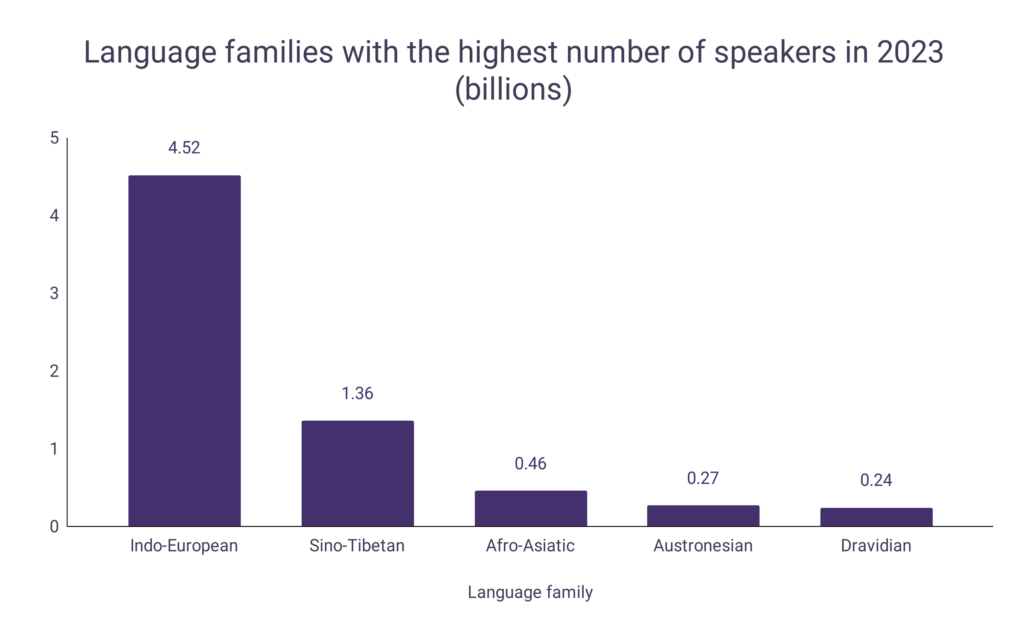- English is the most spoken language in the world with a total of 1.46 billion speakers and it is also the most widespread language geographically.
- As of 2023, the number of English speakers increased by 0.69% over the previous year.
- Over the 2019 – 2023 period, the total number of English speakers increased by 29.20%.
- Mandarin Chinese with 1.14 billion speakers is the only other language to exceed a billion speakers.
- Hindi (0.61 billion speakers) and Spanish (0.56 billion speakers) both exceed half a billion speakers.
- However, Hindi was the only language given to have its number of speakers decrease over the 5-year period (-1.61%).
- French speakers showed a year-on-year increase of 14.81%, higher than any other given language.
- However, Urdu saw the biggest speaker increase over the given 5-year period (+35.29%).
- The number of Modern Standard Arabic, Bengali and Russian speakers remains stable.
- 66.46% of the world’s population speaks at least one of the top 10 most spoken languages as of 2023.
| # | Language | 2019 | 2020 | 2021 | 2022 | 2023 | Chg. (22-23) | Chg. (5-year) |
| 1 | English | 1.13bn | 1.27bn | 1.35bn | 1.45bn | 1.46bn | + 0.69% | + 29.20% |
| 2 | Mandarin Chinese | 1.12bn | 1.12bn | 1.12bn | 1.12bn | 1.14bn | + 1.79% | + 1.79% |
| 3 | Hindi | 0.62bn | 0.64bn | 0.60bn | 0.60bn | 0.61bn | + 1.67% | – 1.61% |
| 4 | Spanish | 0.53bn | 0.54bn | 0.54bn | 0.55bn | 0.56bn | + 1.82% | + 5.66% |
| 5 | French | 0.28bn | 0.28bn | 0.27bn | 0.27bn | 0.31bn | + 14.81% | + 10.71% |
| 6 | Modern Standard Arabic | 0.27bn | 0.27bn | 0.27bn | 0.27bn | 0.27bn | = | = |
| 7 | Bengali | 0.27bn | 0.27bn | 0.27bn | 0.27bn | 0.27bn | = | = |
| 8 | Portuguese | 0.23bn | 0.25bn | 0.26bn | 0.26bn | 0.26bn | = | + 13.04% |
| 9 | Russian | 0.26bn | 0.26bn | 0.26bn | 0.26bn | 0.26bn | = | = |
| 10 | Urdu | 0.17bn | 0.17bn | 0.23bn | 0.23bn | 0.23bn | = | + 35.29% |
If you are interested in learning new English words to help you grow your personal dictionary for word games, check out the WordsRated Word Finder!
First-language vs. second-language split
- Of the top 10 most spoken languages in the world, Portuguese has the highest percentage of first-language speakers (89.73%).
- Spanish has the second-highest percent of first-language speakers (86.76%) and Bengali comes third (85.71%)
- Modern Standard Arabic is learned as a second-language as Arabic speakers must first focus on learning their relevant local dialect.
- After doing so, Modern Standard Arabic is normally learned through formal education.
- English and French have the second and third-highest percentage of second-language speakers (73.92% and 73.87%) respectively.
- This is in part due to their importance in countries and regions where other languages are more widely spoken.
| # | Language | First-language | Second-language |
| 1 | English | 26.08% | 73.92% |
| 2 | Mandarin Chinese | 82.51% | 17.49% |
| 3 | Hindi | 56.46% | 43.54% |
| 4 | Spanish | 86.76% | 13.24% |
| 5 | French | 26.13% | 73.87% |
| 6 | Modern Standard Arabic | 0.00% | 100.00% |
| 7 | Bengali | 85.71% | 14.29% |
| 8 | Portuguese | 89.73% | 10.27% |
| 9 | Russian | 57.65% | 42.35% |
| 10 | Urdu | 30.60% | 69.40% |
A graph is given below to show the top 5 most spoken languages split by their percentage of first/second-language speakers:

Most spoken language families
Analysis of 32 of the most spoken languages with full 5-year data shows which language families are most widely used around the world.
- As of 2023, Indo-European languages are spoken by at least 4.52 billion people.
- This makes Indo-European languages around 1.63 times more common than all other listed language families combined.
- Sino-Tibetan languages have at least 1.36 billion speakers (2nd) and Afro-Asiatic languages have at least 0.46 billion speakers (3rd).
- Afro-Asiatic languages also showed the highest percentage increases from 2022 to 2023 (+6.83%) and also over the given 5-year period (+13.21%).
| # | Family* | 2019 | 2020 | 2021 | 2022 | 2023 | Chg. (22-23) | Chg. (5-year) |
| 1 | Indo-European | 4.04bn | 4.21bn | 4.33bn | 4.46bn | 4.52bn | + 1.38% | + 11.76% |
| 2 | Sino-Tibetan | 1.32bn | 1.34bn | 1.34bn | 1.34bn | 1.36bn | + 1.72% | + 2.77% |
| 3 | Afro-Asiatic | 0.40bn | 0.42bn | 0.42bn | 0.43bn | 0.46bn | + 6.83% | + 13.21% |
| 4 | Austronesian | 0.27bn | 0.27bn | 0.27bn | 0.27bn | 0.27bn | – 0.11% | + 0.04% |
| 5 | Dravidian | 0.23bn | 0.23bn | 0.24bn | 0.24bn | 0.24bn | + 0.54% | + 5.03% |
| 6 | Japonic | 0.13bn | 0.13bn | 0.13bn | 0.13bn | 0.12bn | – 1.91% | – 4.13% |
| 7 | Turkic | 0.08bn | 0.09bn | 0.09bn | 0.09bn | 0.09bn | + 2.16% | + 12.92% |
| 8 | Austroasiatic | 0.08bn | 0.08bn | 0.08bn | 0.09bn | 0.09bn | + 0.82% | + 11.83% |
| 9 | Koreanic | 0.08bn | 0.08bn | 0.08bn | 0.08bn | 0.08bn | + 0.37% | + 6.22% |
| 10 | Niger-Congo | 0.10bn | 0.10bn | 0.07bn | 0.07bn | 0.07bn | + 0.84% | – 26.75% |
A graph is given below to compare the language families with highest number of speakers as of 2023:

The most spoken languages in the world FAQ
What is a world language?
- World languages are geographically widespread and allow people who speak different languages to communicate through a common means.
- The English language is often considered to be the principal, or even the only, world language.
- Beyond English, there is no official agreement around which languages should or should not be considered world languages.
- Despite this, Arabic, French, Russian and Spanish are considered to be possible world languages, while Latin was previously considered to qualify as one by some authors.
How many languages are there in the world?
- It is generally acknowledged that there are in excess of 7,000 languages in the world.
- However, this number is declining over time due to many factors, such as globalization and linguistic imperialism.
- De Swaan created the global language system in 2001, categorizing each language as follows:
- Hypercentral – English.
- Supercentral – Arabic, Chinese, English, French, German, Hindi, Japanese, Malay, Portuguese, Russian, Spanish, Swahili & Turkish.
- Central – Around 100 languages.
- Peripheral – All remaining languages.
- Progressing from the top of the scale to the bottom sees languages gradually decrease from those relevant on a global-level down to those on a local-level.

